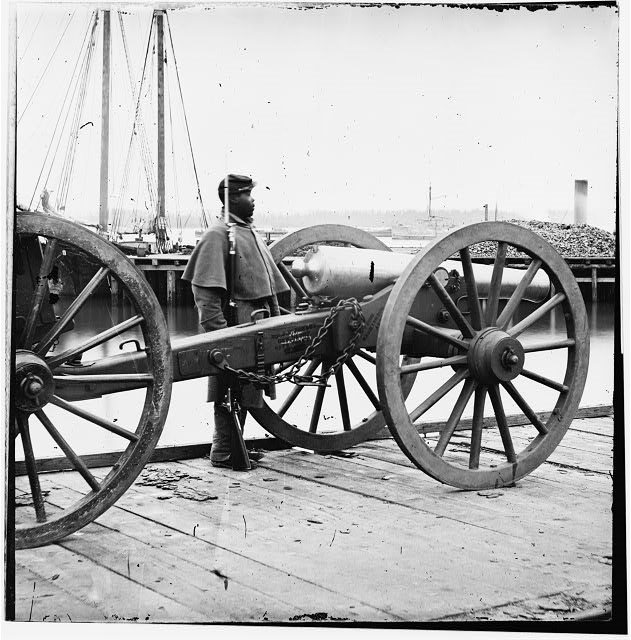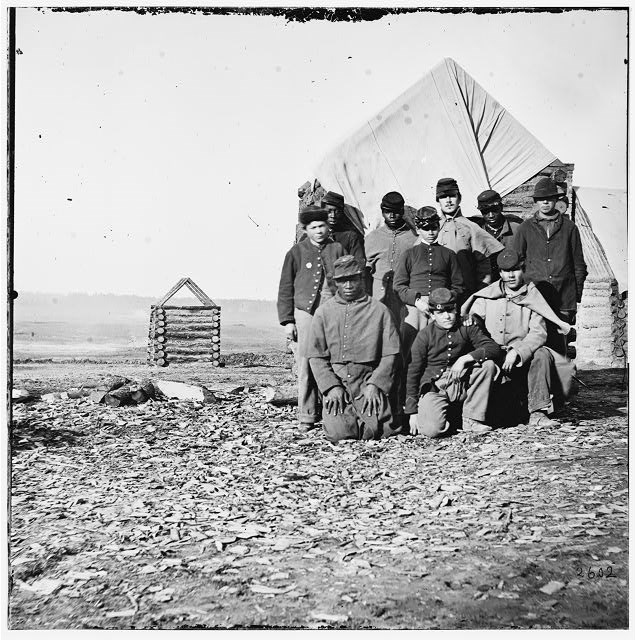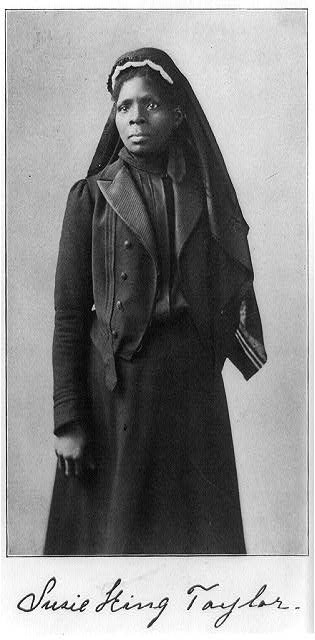Part of a series of articles titled A Timeline of Resistance: The Perseverance of African Americans from the Revolutionary War to the Civil Rights Era.
Article
Civil Rights and the Civil War in the National Capital Area

Photographer Unknown, 1863-1865 - Library of Congress.
In his last words as he said, “I John Brown am now quite certain that the crimes of this guilty land: will never be purged away; but with Blood.”
Though John Brown’s failed raid and attempt to rally enslaved persons and supporters in Harper’s Ferry ended in disaster, it can be seen as a rehearsal of the coming Civil War.The morality of slavery played a heavy role in the abolitionist cause, of which Brown became a national symbol, while the economics had swayed slave states to retain and or gradually remove slavery over time. With Congress being primarily controlled by pro-slavery Democrats throughout the 1800s. The South’s dependence on its agricultural industry as a main source of income relied on slave labor to keep all profits gained. And with the industrialized North’s factories, crucial markets for Southern cotton kept the Northern and Southern economies connected. But with the westward expansion of United States territory throughout the 1800s, the question of which states would become slave and free states was important. The Compromise of Missouri in 1850 resulted in slave state status of Missouri and creation of a free state, Maine. But pro-slavery and anti-slavery forces fought over future states, often leading to bloodshed. Bleeding Kansas, a bloody conflict in the Kansas territory between 1855 and 1859, led as a prophecy of the coming Civil war. Compromises were not enough. With the election of President Abraham Lincoln, the secession of Southern states from the Union, and the attack on Fort Sumter on April 12, 1861, the spark to ignite the Civil War was lit. Read more on the causes of the Civil War and the role of slavery here.
In the first months of the war, only small skirmishes had been fought. But these small-scale fights would only build up to a larger battle. On July 21st, 1862, the First Battle of Manassas, Virginia, Confederate and Union forces fought tooth and nail. Being led by Pierre Gustave Toutant-Beauregard, the Confederate forces snatched victory from the Union forces led by Irvin McDowell. With the war raging on, racist laws had barred African American men from enlistment since 1792. But the DC emancipation act of 1862 became a good omen of what was brewing during the war. The Battle of Antietam on September 17, 1862 was considered the bloodiest day in American history. With more than 23,000 casualties suffered by both sides, Confederate General Robert E. Lee’s offensive in the national capital area was halted by Union General George B. McClellan into a stalemate. The standstill provided President Abraham Lincoln with enough of a victory that would embolden him to make a radical change.
This timeline walks you through how African Americans contributed to saving the Union, fought for their freedom and future generations, and shifted the struggle from emancipation to equal and civil rights in the coming Reconstruction Era. Information from this timeline is provided by Historic Resource Study: Reconstruction and the Early Civil Rights Movement in the National Capital Area by Cheryl LaRoche, PhD, Patsy Fletcher, Caroline Spencer, and Lauren Hughes. It is also supported by African American Experience Before Emancipation: Historic Context Narrative by John Bedell and Andrew Wilkins, and digital content from national parks in the national capital area.

1861-1865 - Library of Congress
From Slavery to Liberation 1860-1863
1860 - Twenty percent of free Blacks owned real estate, their property averaging $317, a decline of a third since 1850. By contrast, the average farm was worth $8,700, an increase of 15 percent since 1850.
1861 – The state of West Virginia formed after Virginia seceded. County delegates from 25 counties met at the First Wheeling Convention, repudiating the secession from the Union. Six months later, the Second Wheeling convention reconvened making it official.
Two days before his first inauguration in March, Lincoln and the Republicans proposed a draft of the 13th Amendment: the Corwin Amendment, or first 13th Amendment. It embedded slavery and prohibited Congress from abolishing or interfering with slavery allowed in the states. This amendment was never ratified.
On July 21, 1861, the Battle of First Manassas was fought by Confederate forces under General Pierre Gustav Toutant Beauregard and Union forces under General Irwin McDowell. Initial Union victories were dashed when Confederate reinforcements arrived. This would cause panic in McDowell's army causing them to retreat to the defenses of Washington DC.
1861-62 - In August 1861, Union Major General Benjamin F. Butler saw that the slave laws such as the Fugitive Slave Act that once governed the Southern states no longer applied for them. Any freedom seeker that found their way to Fort Monroe were then “contrabands of war” and were not required to return to their enslavers. This policy became known as the Contraband Decision.
The Militia Act of July 1862 freed enslaved people in Union-occupied areas whose holders failed to demonstrate “continuous loyalty” to the Union. Anyone who had escaped slavery and was subsequently captured by the Union Army was not subject to return to the enslavers but was considered forfeited to the army.
The Compensated Emancipation Act of 1862 ended slavery in Washington, DC, April 16.
Between August 20-21, the 2nd Battle of Manassas happened on the same grounds as the first battle with the same results. The Union would bare another loss.
The Battle of Antietam in Washington County, MD, repulsed the Confederate Army of Northern Virginia’s first invasion in the north on September 17. The battle gave Lincoln a sufficiently significant victory to announce his preliminary Emancipation Proclamation on September 22, which he had prepared earlier that summer. Intended to weaken the Confederacy, Lincoln chose this victory to declare that slavery would end in the rebellious states on New Year's Day, 1863.

"Reminiscences of My Life in Camp." 1902 - Library of Congress
From Liberation to Mobilization 1863-1865
In the beginning, the war was about secession and stopping the expansion of slave states into new territory. But with heavy losses caused by the Battle of Antietam, it was in the Union’s best interest to diminish the Confederate workforce. When President Abraham Lincoln passed the Emancipation Proclamation of 1863 freeing the enslaved population of the Confederacy in order to achieve that goal, he put into action the gradual end of slavery in America. The Emancipation Proclamation did not free the enslaved in the national capital area and other Union states, but the process of abolishing slavery happened in different places and times. African American men, both free and enslaved, pursued the chance to fight or die to secure freedom, as Frederick Douglass said,
“From East to West, from North to South, the sky is written all over, “Now or never.” Liberty won by white men would lose half its luster. “Who would be free themselves must strike the blow.” “Better even die free, than to live slaves.” This is the sentiment of every brave colored man” (Bedell, Wilkins, 2022).
The United States Colored Troops were established shortly after the Proclamation went into effect on January 1, 1863, and nearly 200,000 African American men would join the United States forces. The newly formed regiments numbered over 170 regiments. The most-known among them was the 54th Massachusetts Infantry, which recruited free and recently self-liberated African Americans from Massachusetts and inspired the national capital area and border states to join forming regiments in their states. Their assault on Fort Wagner, while ending in defeat, showed America that Black soldiers proudly and fiercely fought for the Union. The 4th Colored Regiment served at Monocacy, the 28th Regiment of U.S. Colored Troops were attached to the Defenses of Washington. Waterways had already used Black men to work on canals and water transportation like the Chesapeake and Ohio Canal and Potomac River as a whole. 19,000 African Americans served in the Union Navy, but the nature of ships and theirclose working environment meant ships were racially integrated (Reidy 2017).
Abolitionists such as Sojourner Truth, Frederick Douglass, Harriet Tubman and more encouraged and supported the war effort. They knew that if anyone was to fight for freedom, it needed to be African Americans.
Timeline 1863-1865: “We are passing through times that will secure for us a higher and nobler celebration.”
1863 - The Emancipation Proclamation was issued on January 1, 1863, declaring that "that all persons held as slaves" within the rebellious states "are, and henceforward shall be free." Additionally, the declaration added that the military and naval forces would enforce the freedom of the formerly enslaved in the Confederate states and would “do no act or acts to repress such persons or any of them in any effort they may make for their actual freedom.” It also declared that “such persons [African American men] of suitable condition, will be received into the armed service of the United States.” Black soldiers could now legally fight for the US Army.
Two African American regiments were recruited in Maryland, the 7th and 19th U.S. Colored Troops. Training for Black troops operated on Theodore Roosevelt Island while serving as a refugee camp for the recently liberated African Americans.
By May 1863, Arlington House had been selected by Elias M. Greene, Chief Quartermaster of the Department of Washington, and Danforth B. Nichols of the American Missionary Association for another purpose: the establishment of a Freedman’s Village on part of the plantation that had been seized from Robert E. Lee at the beginning of the war. The community was created to give recently liberated African Americans shelter, food, clothing, medical attention, education and more.
1863, 1865-1866 - The 4th USCT was organized in Baltimore, Maryland in July 1863, and saw action in Virginia and served in DC in 1865-66.
1864 - The National Equal Rights League was founded in Syracuse, New York by abolitionist Frederick Douglass to lobby for equal rights and anti-segregation policies and rally on behalf of black men’s voting rights. Its widespread lobbying initiatives led to the successful pressure on Congress to pass the Fourteenth Amendment in 1866-1867, thus facilitating preliminary civil rights, but not universal suffrage, for southern and northern Blacks.
Alexandria, VA’s first celebration of British West Indian Emancipation took place in the Colored Hospital renamed L’Ouverture in honor of the Haitian liberator. It was organized by Harriet Jacobs, who stated in her opening speech, “We are passing through times that will secure for us a higher and nobler celebration.”
The Battle of Monocacy, fought on July 9th 1864, was not a large-scale battle, but its importance can not be forgotten. It helped Union forces led by Major General Lew Wallace slow the march on Washington DC by Confederate forces led by General Jubal Early. It is seen as “the battle that saved Washington.”
At the Battle of Fort Stevens, the only battle fought in Washington DC, an outnumbered United States Army force delayed a Confederate force long enough to enable reinforcements to reach Washington, DC to counter any attack.
While the Emancipation Proclamation went into effect on January 1st, 1863, Maryland officially abolished slavery in 1864.
1865 - The Freedmen’s Bureau, headquartered in Washington, was established to help the newly freed transition into their new status. Much of the work centered on attempting to protect the civil rights of freed people of color.
Late 1865 or January 1866 Leesburg Black citizens establish a “Colored Man’s Aid Society” to assist their infirm and indigent. It was one of many mutual aid societies established during and after the Civil War meant to be the backbone of civil society in America.
By 1865, African Americans and allies were preparing the social landscape for a society without slaves as Union victories against the Confederacy were being made in Confederate territory. The danger of Confederate invasion was destroyed, and the war was being won by Union forces pushing through the South. By the end of the Civil War in 1865, it is estimated that some 40,000 African Americans had self-liberated and come to Washington alone. Under a new and unified union of the United States, the dream of a free and equal country invigorated and stimulated African Americans. Though the years after the Civil War have been considered a failure, the Reconstruction era laid the foundation for the fight for civil rights and the struggle against racist policies and laws.
Works Cited
Bedell J and Wilkins A. 2022. African American Experience Before Emancipation: Historic Context Narrative. Historic Resource Study. National Park Service. Washington, DC
DataStore – (African American Experience Before Emancipation: Historic Context Narrative)
LaRoche CJ, Fletcher P, Hughes L, Spencer C. 2021. Thematic Framework for the History of Civil Rights in the National Capital Area. NPS Special History Study. National Park Service. Washington, DC
DataStore – (Thematic Framework for the History of Civil Rights in the National Capital Area)
Unrau HD. 1976. The C & O Canal During the Civil War: 1861-1865. National Park Service, Denver Service Center. Denver, Colorado
DataStore – (The C&O Canal During the Civil War: 1861-1865)
Tags
- antietam national battlefield
- arlington house, the robert e. lee memorial
- chesapeake & ohio canal national historical park
- fort sumter and fort moultrie national historical park
- harpers ferry national historical park
- manassas national battlefield park
- monocacy national battlefield
- reconstruction era national historical park
- theodore roosevelt island
- civil rights
- national capital area
- african american history
- civil war
- black soldiers
- national capital region
- ncro
- nca
- national capital area parks
- national capital region office
- ncr
- history
- black history
Last updated: January 10, 2024
